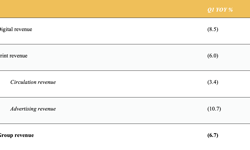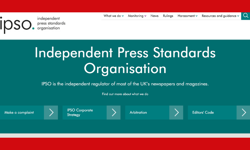Oh for those days when the circulation director got back from lunch (might have been 2.45-ish!) to turn their attention to what might add an instant 10 or 15% to sale and, without having to think too hard, called his or her promotions manager and uttered the word ‘Bingo!’ And, of course, ‘Bingo!’ was right; the required volume lift was usually spectacularly delivered. The headlines that accompanied the gamecard might have read of Margaret Thatcher’s Conservatives seeking a second term in office, of Madonna releasing another single destined to be a No 1 hit, of Liverpool walking away with the Championship (yes, it used to be an annual event - sorry Kopites) or of some unfortunate teenager rushed to hospital to be released from their over-ambitiously-tight drainpipe jeans.
‘Cross the ball’ might well have been a regular feature of our papers too during this era, but this was largely viewed as a means of generating revenue rather than as a sales driver.
A lot of water, and some other stuff, has flowed under the proverbial bridge since the 80s. Halcyon days! Or were they?
Editorial content was king and the editor reigned supreme. The notion of the complete content package, with advertising or, God forbid, promotion constituting a reason for purchase in their own right, had not yet become even remotely acceptable. The success of Bingo, though, was beginning to erode this position.
Whose front page is it anyway?
Picture a promotions exec asking for a front-page plug. It conjures up images of Oliver! In fact one (now senior) newspaper sales executive re-tells the story of the deputy ed who blurted out: "I’m not putting free ******* burgers on my front page." His front page. Interesting point of view. Shared ownership to him clearly meant an apartment in Spain. Undeterred, our intrepid balloon blower (that’s what promotions do, isn’t it?) stuck to their guns. The page 1 message was eventually carried in all its greasy glory and sales were up by 4% on the night. Must’ve been the impact of that poll tax story!
Despite this (rare?) example of bare faced effrontery, the role of many promotions staff was still to accept the booty very willingly offered (I wonder why?) by PR agencies, via press release, and re-package this into a medium sized ad space as a competition or offer. Adding some value, perhaps, for existing readers but not really contributing beyond this.
Customers were still seen as a homogenous mass that would accept, and be happy with, pretty much whatever they were offered. Their loyalty seemed assured. But the time bomb was ticking.
Birth of the product package
As the incessant nature of the downward pressure on sales volumes really started to dawn on the industry, there started a re-positioning of promotions teams; a metamorphosis that carries on apace today. Actually communicating to the uncommitteds exactly why they should be buying - whether that be for editorial content, advertising platforms, promotional offers, whatever – was, in itself, a remarkable watershed in how newspapers behaved. The idea of the product package, with different elements adding real and highly individual value for different customer groups, had been conceived.
So, from performing a passive product enhancement role, the expectation shifted from ‘promotion’ to ‘sales promotion’ - a small but, at the same time, seismic shift.
Allied to this, the saviour that had been Bingo was starting to lose its magic. All of a sudden, more creativity and pro-activity were both required and expected. Such as:
* Negotiating deals that secured high profile multi-day promotions with token or answer collect mechanics and often linked to a bulk sale to add weight to the launch by getting the newspaper into the hands of non-buyers on day 1.
* Producing in-paper ads and, perhaps, stock newsbills targeted at irregular purchasers informing them of the key platforms as being reasons to buy.
* Securing product to giveaway, as an incentive to purchase copies of the newspaper at events or high footfall outlets.
* Setting up reader clubs as a means of rewarding the loyalty of regular purchasers. A loyalty, which had, until recently, been taken for granted.
These and many other such tasks had become the norm for the newly styled sales promotions teams around the industry and remained so for some time, partly due to their success in adding single copy sales and giving a new impetus to canvassing.
But to quote McCartney (Live & Let Die, 1973): "In this ever changing world in which we live in," significant changes in our industry structure and marketplaces meant that further evolution was essential.
Changes to ABC rules rendered many of the activities now being undertaken by SP teams as questionable at best and obsolete at worst. The decline of home delivery, as a result of shifts in the news retail landscape, meant that maintaining purchasing frequency was now even more challenging. Pressure for enhanced profit margins by shareholders was resulting in reduced budgets and a demand for more accountability. And if all that wasn’t enough, our consumers were becoming even more individual and discerning in their information requirements and consumption habits, due to changing lifestyles and new channels of delivery.
What to do about that lot, then? And how have our intrepid sales promotion (nee promotions) teams responded?
In overall terms, the role certainly seems to have broadened and now might be better termed as ‘consumer marketing’. Working smarter, harder with reduced resources, increased legislation, improved information and higher expectations. Suddenly balloon blowing has something of a romantic appeal!
Activity is now expected to:
* Complement and enhance the brand.
* Be highly relevant to the target audience profile.
* Take account of multi brands and channels.
* Be fully integrated.
* Be accessible.
* Generate interaction.
* Be topical.
* Be measurable and, in so doing, inform the future planning process.
All this text book stuff but still with the inevitable pressure to sell more papers! So, specifically, what is happening today at newspapers around the country?
Multi-functional approach
The concept of multi-functional brand, product and project plans and teams is at the heart of how this new way of working is being achieved in some places. No hierarchies - just a clearly documented, shared vision of what is required and a willingness to take down the departmental barriers that still too often exist. Our consumer marketers still have diverse reporting lines at different publishing centres - newspaper sales, marketing and editorial but, frankly, this shouldn’t matter if this joined up approach is taken. And, very often, the best person or team to co-ordinate is … guess whom! Yes – the promotions / consumer marketing teams!
Much more thought is being given to communicating activity to key audience segments (individuals and groups/organisations). These are being accessed via direct marketing, email, SMS, web banners and targeted outdoor-style promotion; augmenting the more traditional one-size-fits-all approach of newsbills, an occasional blast of broadcast media advertising and ads in our own publications. More about this latter point in a moment.
Publishers are beginning to realise the value and scale of their promotional package offer by attracting major national brands as partners. Offering a single simple proposition, one point of contact and high penetration exposure in a wider marketplace via a combination of titles, allied to the high-trust relationship readers have with their local paper can be a powerful set of tools for building partnerships which, in the past, would have been deemed unlikely at best.
And, a combination of these influences is beginning to lead to much better, fully integrated campaigns delivering excellent results for both our partners and ourselves. But how do we define ‘excellent’?
Number of entries or redemptions remains a key measurement factor but what does represent a good result? 1,000 which generate no additional sale or just 10 that do? Often, now, these are as likely to be submitted using email, text message or telephone as they are to arrive on a good old fashioned coupon - offering customer choice but complicating the picture further. And, given the complex myriad of other influences, is it ever really robust to pin a precise positive sales result on a promotional activity? To counter this, activity is now starting to be judged by some publishers in a number of different ways:
* Securing loyalty
* New relationships built
* Fresh lifestyle data captured
* General levels of interaction
* ‘Other’ revenues (eg. sponsorship, telephony)
* Editorial content generated
* Delivery orders placed on the back of said activity
* Return on investment (a value judgement on all of the above against time, space and actual costs allocated)
Various publishers have, over the last year or so, run rail ticket promotions and these have been an outstanding success in terms of sales (regularly adding 5% across 2-3 week durations) and redemptions (often at around 15% of copy volumes). So why? It’s because, unlike flight offers or competitions to win dream homes, cars or cruises, many different profiles of reader can relate to the activity and find a reason to participate whether it be business or pleasure. It’s accessible, genuinely offers a significant saving and is easy to participate in - for everyone.
A more socialist approach
And this further supports the theory that the balance of power is continuing to shift from the ‘capitalist’ one-winner-takes-all competition ethos towards a more ‘socialist’, something for everyone, offer-led approach. This can be further evidenced by the success of many recent ‘promotions with a social conscience’. People do like to be given an opportunity to put something back into their community and have readily supported such newspaper activity as an easy (and guilt-reducing) way for them to do this as part of their ever-busier lives.
Although, where prize competitions do remain attractive and popular is where they are skilfully targeted at niche groups to win things ‘that money can’t buy’ and the instant win format where cash can be won - on the day.
Alongside taxes and death, the prospect that our industry and the dynamic marketplaces it serves will continue to change is a cert.
So what does the future hold? And how do we track the ways in which consumers are changing? As reported recently in Sales Promotion, the 2005 National Incentive Survey revealed that:
* BOGOF offers are most influential with 42% of people responding to such activity
* 30% of respondents will take part in in-store activity
* Fast-becoming-acceptable email communication came in at 20%
* Free samples would influence 19% of people
* 17% said they would respond to promotional activity in newspapers
* Loyalty card activity and points appealed to only 8%
If nothing else, this demonstrates once again that we are now dealing with tens of thousands of individual consumers rather than a large generic rump of readers.
This suggests that the only possible way of giving them what they want is to build a personal relationship with as many as possible. Many publishers have, to one degree or another, toyed with the concept of CRM or consumer databases. Tony Coad’s article, in the last issue of InCirculation, highlighting the approach being taken by Paul Hayes and his team at the Times made excellent reading but few in the regional press have got past the reading and nodding of heads stage and moved towards a whole-hearted adoption of this mindset.
Life time value
If that’s down to cost then consider this. Over a 30-year lifespan, an average issue daily title reader contributes around £100 of gross revenue per annum, based on their newspaper purchase. So £3,000 over the period. Selling the same person a cruise for two people would, in one fell swoop, almost double this. Then think about financial services, referrals to car dealers … the list goes on. And the more we do business with them, building on the loyalty and trust that exists, the more money we’ll make. But as well as that, we’ll get to know even more about them, ensuring that our products and services remain highly appropriate to them, and likely, to others of a similar profile. More than anything else, this will reward and secure customer loyalty. A kind of virtuous circle.
We talked earlier about the improvements that had taken place in the way consumers and potential consumers are communicated with. However, it remains a real challenge for regional publishers to really harness the value of so-called ‘house’ advertising much more effectively and efficiently. Perhaps the answer is to create a small team comprising an experienced media planner and an editorial graphic designer, under the wing of the consumer marketing (brand management) function to generate improved return on this significant but undervalued, almost ‘hidden’ investment. Can you imagine a sales rep for Coca-Cola being allowed to commission a trade press ad to promote a local sales drive? Such a scenario is quite possible at a regional newspaper publisher, where any number of people in the organisation may take it upon themselves to place an ad in the paper.
Should regional press move further towards the radio model (which has been used for sometime by the Blackpool Gazette and was recently adopted by the Evening Standard) that puts a premium price on promotional space and activity, thus turning it into a true commercial revenue stream? Certainly this can be justified in terms of added value and results for the client but might create an uncomfortable juxtaposition with attracting appropriate activity while it still has a role to play in generating copy sales of our printed editions?
And this just in. Although we might have moved a long way from where this story began, let’s not forget that the balance must not be allowed to swing too far. Good quality writing and news exclusives are still up there as being our bread and butter.
Sorry, but my crystal ball has suddenly gone all foggy, so I can’t begin to do proper justice to what else the future may hold in the remainder of this piece. That’s a relief! One thing I can tell for sure, though. Go into that circulation director’s office around the middle of any typical day and you’ll find him or her muttering. No, not about Bingo but more along the lines of ‘Lunch? Chance would be a ****** fine thing!’
| The author would like to thank the following people with whom he talked, mused, reminisced and future-gazed about a shared passion in the preparation of this piece. Sandy Gamlin, Newcastle Chronicle & Journal Stephen Allinson, Yorkshire Post Newspapers Sandra Ciuffini, Coventry Newspapers Patrick Masheder (and team), Newsquest NE |










